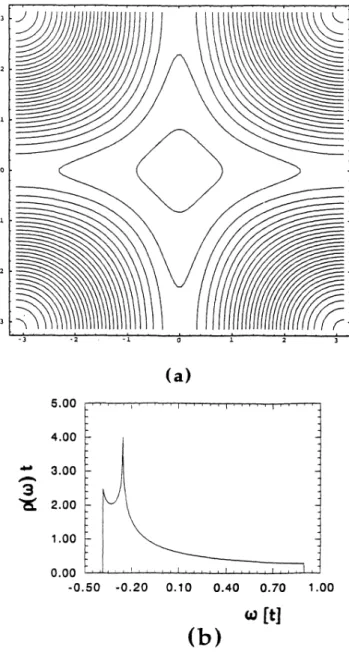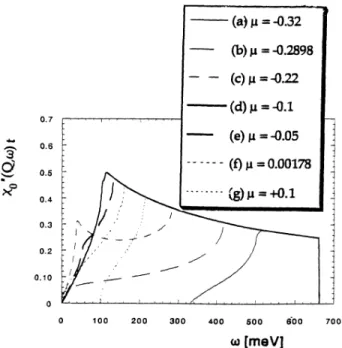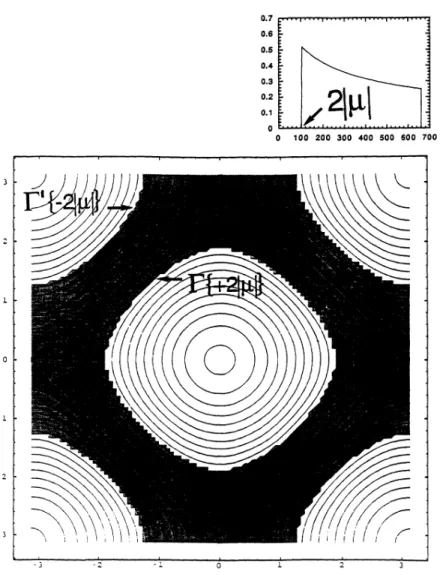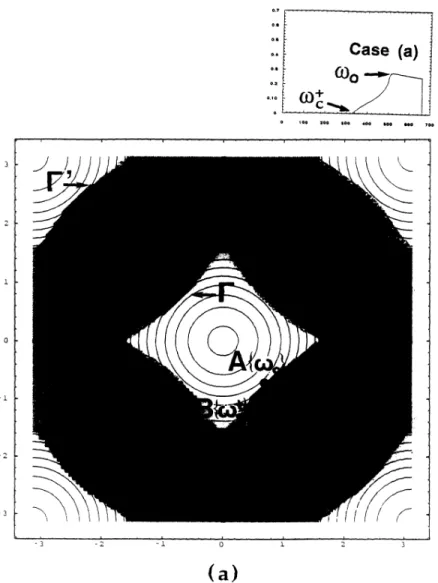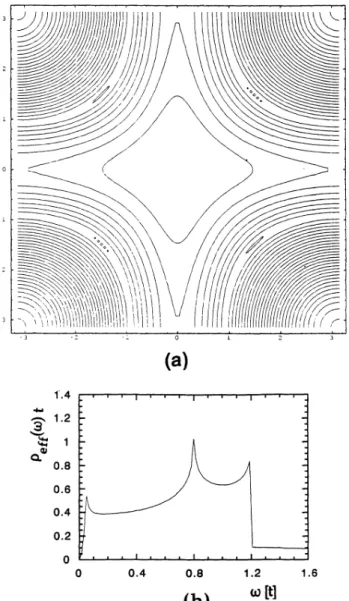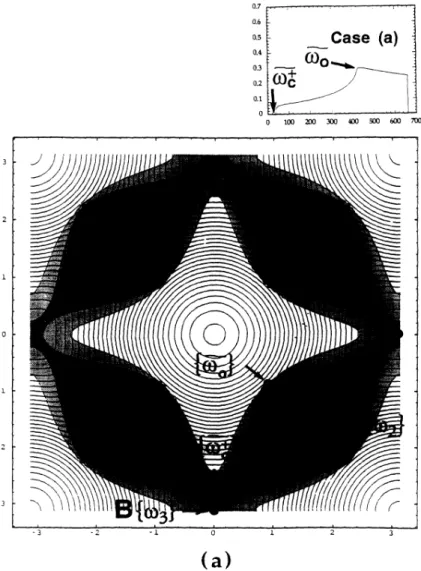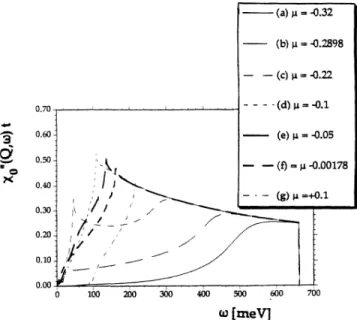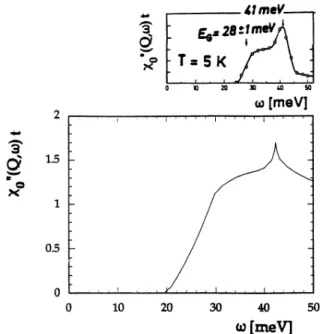HAL Id: hal-01896252
https://hal.archives-ouvertes.fr/hal-01896252
Submitted on 16 Oct 2018
HAL is a multi-disciplinary open access
archive for the deposit and dissemination of
sci-entific research documents, whether they are
pub-lished or not. The documents may come from
teaching and research institutions in France or
abroad, or from public or private research centers.
L’archive ouverte pluridisciplinaire HAL, est
destinée au dépôt et à la diffusion de documents
scientifiques de niveau recherche, publiés ou non,
émanant des établissements d’enseignement et de
recherche français ou étrangers, des laboratoires
publics ou privés.
Spin excitations of two-dimensional-lattice electrons:
Discussion of neutron-scattering and NMR experiments
in high- T c superconductors
M. Lavagna, G. Stemmann
To cite this version:
M. Lavagna, G. Stemmann.
Spin excitations of two-dimensional-lattice electrons: Discussion of
neutron-scattering and NMR experiments in high- T c superconductors. Physical Review B:
Condensed Matter and Materials Physics (19982015), American Physical Society, 1994, 49 (6), pp.4235
-4250. �10.1103/PhysRevB.49.4235�. �hal-01896252�
PHYSICAL REVIEW
B
VOLUME 49, NUMBER 6 1FEBRUARY 1994-IISpin excitations
of
two-dimensional-lattice
electrons:
Discussion
of
neutron-scattering
and
NMR
experiments
in
high-T, superconductors
M.
Lavagna andG.
StemmannCommissariat al'Energie Atomique, Departement de Recherche Fondamentale sur la Matiere Condensee,
SPSMS/MDN, 85X,38041Grenoble, France
(Received 26July 1993)
The spin-excitation spectrum as observed in neutron-difFraction and NMR experiments in
YBa2Cu306+„istheoretically examined inthe weak-coupling limit ofatwo-dimensional Hubbard lattice
model in which the next-nearest-neighbor hopping term t' is considered in order tofit the shape ofthe
Fermi surface observed in angle-resolved-photoemission experiments. The presence of a Van Hove
singularity in the density ofstates atco=4t',no longer centered atthe center ofthe band if t'%0,leads to
correct predictions for the variation ofthe Knight shift with doping when compared toexperiments. As
long as pairing effects are not included, the frequency dependence of
y"
(Q,cu)at T=0
has no gapforthe current regime ofinterest (4t'&p &0),but instead presents a typical double-cusp structure that wedis-cuss. In the presence ofd-wave pairing, it isshown how the spectrum ofexcitations gains four
addition-al superconducting ellipses around the nodes ofexcitations. Consequently at T
=0, y"
(Q,co)exhibits aresonance superimposed on a gap structure which bears striking resembl'ance with the neutron results
re-ported by Rossat-Mignod et al. [Physica B169,58(1991)]in YBazCu3069$ The resonance isanalyzed
asaKohn anomaly ofthe second kind in the Cooper channel. Thevalue ofthe threshold EG evolves
be-tween two different regimes as the chemical potential goes from 0to
4t,
associated with two differentscales for the temperature at which the spin gap fills up. Finally, the Knight shift is calculated showing
aYosida-like law with alinear
T
dependence at very low temperatures as expected for axialsupercon-ductivity in two dimensions.
I.
INTRODUCTIONBesides their high superconducting temperature, one
of
the most important observations made in the newsuper-conductors concerns the aspect
of
the spin-excitation spectrum that they exhibit both above and belowT,
.
Avery intensive effort has been made these past years to
study the excitations in cuprates such as La2
„Sr,
Cu04 (Ref. I) or YBa2Cu30s+„(Refs.
2—
5) using either neutron-scattering or NMR techniques. As far asneu-tron scattering is concerned, let us first summarize the essential results, we11established forsome
of
them or still under discussion for others.(1) In the low-doping regime, both
of
these systems ex-hibit long-range antiferrornagnetic order which disap-pears above a critical concentrationof
oxygen for yttrium compounds or, respectively strontium in lanthanum com-pounds. Nevertheless, in the metallic phaseof
yttrium compounds, the neutron-scattering signal keeps itsmax-imum amplitude around the antiferromagnetic vector
Q=(rr,
m.) as is the case for antiferromagneticcom-mensurable fluctuations. The situation in lanthanum compounds is rather different with the onset
of
incom-mensurate peaks around the four wave vectors(~,
~+5qo),
(m+5qc,m.). In the following we willessen-tially discuss the case
of
yttrium compounds.(2) The q width
of
the neutron-scattering response around its maximum value is rather large, leading to a short magnetic correlation length g.Of
particularimpor-tance is the fact that the correlation length does not
ex-hibit any sizable variations with both temperature and frequency apart from the special behavior around the res-onance outlined further below. On the other hand, one observes a continuous decrease
of
the magneticcorrela-tion length gwhen the concentration
of
oxygen increases.This last feature makes the measurements more and more
difficult with increasing doping since the q widening
of
the response is associated with a reduction
of
the signal itself at the wave vectorQ.
In the following we willessentially discuss the frequency behavior
of
the magnetic form factorS(Q,
co)in yttrium compounds.(3) Well established now is the presence
of
a resonancein
S
(Q,co)forthe superconducting phaseof
highly dopedYBazCu306+„systems
at a characteristic frequencyof
the order
of
41 meV. This resonance was first reported by Rossat-Mignod etal.
for the concentrationsx=0.
92 and1.
0
and has recently been confirmed for the lattercomposition using polarized neutron-scattering
tech-niques. The existence
of
this resonance has not received any interpretation so far, and it is oneof
the purposesof
this paper to answer this question. The fact that the feature disappears aboveT,
brings strong arguments infavor
of
a mechanism based on pairing effects. As wehave already mentioned, this resonance is accompanied by a narrowing
of
the q width,i.e.
, an increaseof
the magnetic correlation length in its vicinity.(4) Still under discussion is the question concerning the existence
of
a gap in the spectrumof
excitationsS(Q,
co)at low temperatures. The neutron-scattering measure-ments performed by the Grenoble group show a continu-ous behavior as afunction
of
doping with the presenceof
0163-1829/94/49(6)/4235(16)/$06. 00 49 42351994
The American Physical Society4236 M.LAVAGNA AND G.STEMMANN
a gap EG
of
values 4, 16, 28,and 26 meV at the concen-trationsx=0.
51,0.
69,0.
92, and1.
0, respectively. Thetemperature
T
at which the gap structure disappears is experimentally identified as the temperatureof
themax-imum
of
y"
(Q,ruo) forcoo«EG
Th. isenergy scaleT
isfound to be larger than
T,
for the first three compositionsin question (and
of
order 130K),
hence the appellationof
spin gap (or pseudogap) in these systems. Oppositely, for
surdoped systems
(x=1.
0),T
just equalsT,
(oforder 90K)
and the gap vanishes immediately aboveT,
as the su-perconducting gap does inBCS
theory. Note the ap-parently contradictory behaviorof
EG andT
with dop-ing:EGIT,
increases withx,
whileT /T,
decreases, reaching the critical value 1for the upperx=1.
0
concen-tration. Moreover, in the spin-gap regime, EG is rather
small toward 2(4ho), reaching a value
of
3.5T,
only in thesurdoped regime. Because
of
the smallnessof
the signalitself (especially at higher doping for which the magnetic
correlation length becomes shorter) and also from the
difficulty
of
extracting the magnetic contribution, thecontroversy isstill open on the existence
of
this spin gap.It
has only been verified by other groups for thecomposi-tion
x=0.
6 (Ref. 4) with the predictionof
a gapof
5meV, properly interpolating between the values found by
Rossat-Mignod et
al.
at the neighboring concentrationsx=0.
51 and0.69.
All the other compositions have so farled to negative confirmations '
in spite
of
the natural ar-guments in favorof
the existenceof
the spin gap provided by the low-temperature behaviorof
the relaxation time on Cu nuclei as discussed below.Of
special interest in this discussion are the NMR ex-periments performed on the same systems. 'Depending on the nuclei considered (Cu,
0,
or Y), the relaxationrates exhibit very different temperature dependence, reflecting the various q filterings involved in each case.
For
Cu, the relaxation time does not follow the usualKorringa law, but instead
(T,
T)
' shows a maximum atT
T,
in heavily doped systems. Again, this maximumcoincides with the superconducting temperature only for
surdoped systems
(x=1.
0).
Given that the form factorof
Cu mostly filters the Q component, it is currentlyac-cepted that the thermal dependence
of
the relaxation rateon copper is directly related to the formation
of
the spin gap inS(Q,
co).For
'0
(and also Y),a rather different behavior has been found with a regular decreaseof
'
(T,
T) ' whenlowering the temperature, starting from
well above
T,
in heavily doped systems.For
surdoped systems, '(T,
T) ' is larger and slightly increases in the normal phase when the temperature decreases beforefal-ling down just below
T, .
The Knight shift is foundto
behave in avery similar way with aconstant coefficientof
proportionality toward '(T,
T)The whole set
of
these experimental neutron-scattering and NMR data constitutes a puzzling problem in that the spin-excitation spectrum drastically differs from a tradi-tional Fermi-liquid behavior. This triggered these last years the developmentof
a certain numberof
theories. Apart from the phenomenological approaches, ' let usquote the nested-Fermi-hquid (NFL) theories which have been derived either in the weak-coupling regime' ' or
in the strong-coupling regime'
'
of
various magneticmodels (Hubbard, tJ-) appropriate to describe the
elec-tronic configuration
of
cuprate layers. All these theories invoke a dynamic nesting property due to the existenceof
flat parts
of
the Fermi surface. They predict the ex-istenceof
a gap in the frequency dependenceof
go'(Q,co)of
value 2~@,~, followed by all the larger jumps since thesystem is closer to the Van Hove singularity
of
the densi-tyof
states existing at half-filling. TheNFL
theories especially in their strong-coupling version lead toin-teresting results concerning the existence
of
a spin gap inyo(Q,
co),the nonmonotonic behaviorof
(T,
T) ' withtemperature, and the prediction
of
short magneticcorre-lation lengths only weakly dependent on temperature. However, they do not succeed in giving the correct order
of
evolutionof
the Knight shift with doping. Even more seriously, recent resultsof
photoemission experiments' have drastically challenged these models by bringingdefinitive proof on the existence
of
the Fermi surfaceof
shape in complete contradiction with the starting
hy-pothesis
of NFL
theories. Precisely, the Fermi surface isfound to be rotated an angle
of
45' toward the assumed picture and its center moved from the points 1(0,0) toS
(~,
~)
of
the Brillouin zone.%hatever will be the final issue concerning the experi-mental controversy about the existence
of
the spin gap, which is,of
course, crucial to settling in the future for abetter understanding
of
the high-T, superconductors, it appeared urgent on the theoretical side to reexamine the question without any a priori assumptions on the ex-istenceof
the spin gap and by taking into account the fullrealistic shape
of
the Fermi surface as emerged from pho-toemission experiments and confirmed by band-structure calculations. This constitutes the purposeof
this paperwith regards to the weak-coupling regime which has the interest
of
already bringing out the main featuresof
the problem. The strong-coupling limit will be considered ina forthcoming paper. ' The first part
of
this paper is de-voted to the studyof
the spin excitations in the normal phaseof
a t-t' Hubbard model in which the next-nearest hopping termt'
is introduced to reproduce the correctshape
of
the Fermi surface. The Van Hove singularity al-ready present in thet'=0
case is then pushed from thecenter
of
the band to~=4t',
which makes the model a much better starting point from a perturbative pointof
view. Results for the spin-excitation spectrum are estab-lished with special emphasis on what becomesof
thedy-namic nesting property and
of
the spin gap at Q= (m,ir). In the second part, the discussion is enlarged to the pres-enceof
d-wave superconductivity.%e
show how the for-mationof
four superconducting ellipses in the spectrumof
excitations deeply affects the formof
the dynamicsus-ceptibility at low frequencies with the prediction
of
a gap followed by a resonance which bears striking resemblanceto the neutron-scattering results mentioned before.
Moreover, the combined effects
of
the anisotropyof
the superconducting gap as well as thatof
the Fermi surface have consequences on the establishmentof
very different regimes for the dynamic susceptibility as the chemical potential goes from0
to4t',
leading toa typical variationof E~
andT
with doping, which might beof
some relevance to account forthe experiments.49 SPIN EXCITATIONS OFTWO-DIMENSIONAL-LATTICE.
.
.
4237II.
NORMAL STATELetus start from the effective one-hand Hubbard Ham-iltonian'
'
considered todescribe theCu-0
singletscon-tained in the layers:
where t and
t'
are the hopping integrals between nearest neighbors(i,
j
)
and next-nearest neighbors(i,
j
)'.
Thelatter one is introduced to fit the shape
of
the Fermisur-face XFobserved in angle-resolved-photoemission experi-ments. These results' confirmed by band-structure
cal-culations show a rotation
of
the axesof
symmetryof
Xzof
an angleof
45 compared to thet'=0
case, with its center moved from the pointl
(0,0) to S(m.,n). U represents the on-site repulsion between particles. Typi-cally, tisof
orderof 0.
5 eV, lt'l varies between0.
1tand0.
4r (we will see further that only negative values arerelevant), and Uis
of
order 5eV.3 ~ 3 2 2 4 ~ 0 -2 ~ -3 -3 -2 -3 -3 -2 6.00
4.
00-3.
00-2.00 5,004.
003.
00 2.00 I f I (I I I I I I ~ I1.
00'-1.
000.00
-1 00 -0 70 -0 40 -0 10020
0.50
I I I I I I I I I I I I0.
00-0.
50-0.
200.
100.
400.70
1.
00FIG.
1. Tight-binding model with positivenext-nearest-neighbor hopping integral
t'.
(a) Energy contours fort'=+0.
45t. Note the open orbits for c&4t' and the closedor-bits for
c&4t'
rotated by 45' compared to the caset'=0
andcentered around (0,0). (b)Density ofstates for the same t' and
t=0.
16. The Van Hove singularity is located ate=4t'.
Notealso that the case ofhalf filling corresponds to apositive value
of psmaller than 4t' so that the density ofstates decreases with
hole doping.
FIG.
2. Tight-binding model with negativenext-nearest-neighbor hopping integral
t'.
(a) Energy contours fort'= —
0.45t. Note that the closed orbits (c,&4t'}are stillcen-tered around (0,0) and no longer rotated, but the open orbits
(c&4t')are centered around (~,m) and rotated by 45'. (b)
Den-sity ofstates for the same
t'
andt=0.
16. The Van Hovesingu-larity is located at co=4t'. In this case half filling corresponds
to anegative value of
p
greater than 4t' sothat the density ofM. LAVAGNA AND
G.
STEMMANNFor
a square-lattice structure, the spectrumof
indivi-dual excitations in the normal state in the absence
of
anyinteraction effects isgiven by
gl,
= —
2t(cosk,
+
cosk ) 4t'—
cosk,
cosk (2)The corresponding equienergetics are represented in Figs.
1 and 2. The spectrum is radically different depending on
the sign
of
t'.
Obviously, thet'(0
regime offers thebetter description
of
yttrium compounds and will be re-tained further. We have performed numerical calcula-tionsof
the densityof
states and reported the results inFigs. 1 and 2 for both positive and negative values
of
t'.
Note the values
of
the band edges ( 4t 4t—')
a—
nd(+4t
4t')
—
and the presenceof
aVan Hove singularity atco=4t'
(difFerent from zero) with an asymmetry comparedto the
t'
=0
case since the singularity isno longer associ-ated with half-filing and makes the model much lesspathological. The corresponding
cu=4t'
equienergetics isthe
"star"
appearing inFig.
2(a), the endsof
which are the saddle points located at (km,0)
and (0,+n
). Below orabove this critical value
~=4t',
the equienergetics are,respectively, closed orbits centered around the point
I(0,0)oropen orbital around
S
(rr,rr).At the unrenormalized level, the imaginary part
of
the unrenormalized dynamic susceptibility is given by»'(Q
~)=
~X
I&F(4)
—
&F(4+g)I&(~
—
4+g+4)
.k
Results
of
our numerical calculations are reported inFigs. 3 and 4, respectively, at zero end finite
tempera-tures. Let us remark that the presence
of
thet'
term deeply afFects the frequency dependenceof
yo(Q,co). The4aa
3
G' ~7 f l ( i ) I I, ( ( g i 0~ 0.6—
0.
50.
4 (a)p=-0.32—
(b)p=-0.2SS —(c} p=-0.22 (d)p=-0.1—
(e)v=-0.05 -(f)p= 0.0 . -(g)p=+0.10.3
0.2
0.
10 0100 200
300
400 500 600 700
«)fmeV]FIG. 4. Spectral weight go{Q,co) vs frequency co without
pairing at
T=300
K,t=75
meV,t'= —
0.45t. The enumerationofcurves isthe same asinFig. 3.
dynamic nesting property observed at
t'=0
with the ex-istenceof
a gapof
value 2~@~ is now replaced by thefol-lowing behavior: (i)The two opposite regimes (closed
or-bits at
p
(4t'
or "small open orbits" atp)
0) lead to the formationof
a gap in the frequency dependenceof
go'(Q,co). (ii)"Large
open orbits" such as4t'&p(0
show no gap but instead a characteristic "double-cusp"
structure asshown in Fig.
3.
Our results at zero temperature are in agreement with
the analytical results derived by Benard, Chen, and Tremblay in a recent report. ' However, while the method they used is restricted to zero temperature, the numerical approach that we developed has no limitation
of
this type and has been as well applied to finitetemper-(aj)t
=
4.
32 0.7 0.6 0.5 (b)It=
4.
2898 (c)It=
4.
22 (d) p=-0.
1 (e))t=
4.
05 ---(f))t=0.
00178 0.4 0.3 0.2 0.10 100 200 300 400 500 600 to[meVJ 700FIG. 3. Spectral weight 1'o'(Q,col vs frequency co without
pairing at zero temperature:
t=75
meV,t'=
—
0.45t. Theenumeration ofcurves isinaccordance with Table
I.
FIG.5. Equienergetics g~+&
—
g&=co~st[Q=(n.
,~)]
corresponding to spin-excitation energies in the normal phase
SPIN EXCITATIONS OFTWO-DIMENSIONAL-LATTICE.
.
.
atures as shown in Fig.4.
%e
propose here a simplegeometrical interpretation
of
the results. The densityof
excitationsof
electron-hole pairsof
momentum transferQ derived from
g„+&
—
gk=4t(c
osk,+c
osk„)
is not affected by the presenceof
thet'
term and itscorrespond-ing spectrum isrepresented in
Fig. 5.
The densityof
pair excitations can then be expressed in termsof
complete el-liptic integrals with acharacteristic Van Hove singularityat
co=0.
In order to get to yo(Q,co),one has to consider the additional effectof
the Fermi factor [n~(g k)n~(—
/k+&)]
which acts as an extinction factorat zero temperature.
For
t'
=0,
the boundaryof
the extinction factor exactly coincides with the equienergetics gk+&—
gk=
2~p
~ (cf.Fig.
6) and the resultof
dynamic nesting derived by Bulut and Scalapino' and developed further''
'
can be easilydeduced from the figure (for
co)
0):
yo(Q,
co)=
—
8(co—
2~@~)pc(a)/2),
withpc(co)
=
1K
IV
I (co/4t')]—
kind. In this case a threshold in the spectrum
of
excita-tions yo(Q,co)
of
value 2~)M~ followed by all the largerjumps arises since the system is close to the Van Hove singularity in the density
of
states existing at half-filling.The
t'%0
case differs by the shapeof
the Fertni factor.One can distinguish three regimes as represented in Fig.
7.
(i)
For
p&4t'
(closed orbits), the delimitationsof
the extinction Fermi factors are given by the curvesI(gk=p)
andI"(gk+&=p,
) shown in Fig. 7(a).For
co)coo (coo corresponding to the equienergetics passing
through points
of
type A), the Fermi factor does not have any extinction role and the response isthe full com-plete elliptic integral as in the case fort'=0.
For
~,
+(co
&coo (co,+ for pointsof
type8),
partof
the com-plete elliptic integral is made extinct, leading to anin-complete elliptic integral form for the response and a cusp in the frequency dependence
of
yo'(Q, co).For.
co(co,
+,
we have yo'(Q,co)=0.
Simple geometric argu-ments give the valuesof
the threshold co,+andof
the posi-tionof
the cusp at coo..
4f
p
2twhere
E(x)
is the complete elliptic integralof
the firstO~l w~~~g g 0.8 P 0.5 r 0.4 0.3 0.2 0.1
.
-0 0 &00 200 300 400 500 600 &00 3 P aFIG. 6, Equienergetics gk+&
—
gk=constwithout pairing. The shaded region does not
contribute to +0'(Q co) because ofthe
extinc-tion role played by the Fermi factor between
the curves I and
I".
In the inset, spectralweight yo'(Q,co) vs frequency co without
pair-ing at T=Ofor
t'=0
For p%.0the vector Qno longer spans the Fermi surface and a gap
ofvalue 2~p~ opens up.
-2
-3
M.LAVAGNA AND G.STKMMANN 49
,j/2
4t
pt'
6700
—,
l 1t2 (6)
Note that there isa critical value
of p
for which the twovalues cooand co, pass each other.
(iii)
For
p)
0
(small open orbits), we find again athreshold in the spectrum
of
excitationsof
value Qo[as-sociated with points
of
type I'"of Fig.
7(c)jfollowed by acusp at co, (point G), beyond which a complete elliptic These values already play a role in the analytic expres-sions obtained in Ref.
l6
forT=O.
(ii) For
4t'
&p &0
(large open orbits), the discussion israther diff'erent as illustrated in Fig. 7(b). Contributions
of
pointsof
typeC
associated withco=0
are responsiblefor afinite response as soon as co&0and there is no gap.
Instead, we find a double-cusp structure at the values ~0
and co, (corresponding to points
of
types D andE)
defined by
—
4t'
~-=z
C2ts
1—
integral form isrecovered for yo'(Q, co). We have
4t
0
1/2
pt
t2
Table
I
summarizes the discussionof
the gap and cusps ingo'(Q,m) in the diff'erent regimes. The values
of
~o,~,
,cu,
+,
and Qo are in perfect quantitative agreement withour numerical calculations. The existence
of
a gap at zero temperature in the two opposite regimes (p&4t'
andp)
0) is simply due to the fact that the vector Q is,re-spectively, larger or smaller than any diagonal vector
(q„=q~)
spanning the Fermi surface F.or
the intermedi-ate regime4t'(p
&0,
which is e6'ectively the case for the rangeof
dopingof
physical systems, the threshold van-ishes and instead a double-cusp structure takes place. The e8'ectof
finite temperatures isto All up the gap whenit exists and smooth the cusp structure as indicated in
Fig. 4,pushing the second cusp to higher values.
The origin
of
the large values reached by yo'(Q, co) isclosely related tothe Kohn anomalies
of
the second kind observed in yo(q,co=0)
at q=2k+.
Typically, one canwrite by changing the variables (gk and gk+&):
00 0.0
Cclse
(gl) 0,10 0 100 $00 000 400 000 000 700 Q ~FIG.
7. Equienerge&ics gk+g—
gk=co
nstwithout pairing at T=O for
t=
75 meV,t'= —
0.45t. (a)case (a)p
&4t' (closed orbits).(b) case (c)4t'&p&
p,
&(large open orbits). (c)case (g)
p
&0{small open orbits). Theconven-tion used for the shaded regions is the same as
in Fig. 6. In the inset, spectral weight yo'(Q,co)
49 SPIN EXCITATIONS OFTWO-DIMENSIONAL-LATTICE.
.
.
4241 k+q k d$k+qdgkl~k4+g
~~kgk
I nF(fk+q ) nF((k) X 4k +q kkThe Kohn anomalies arise when the vector q connects points
of
the Fermi surface for which tangents are paral-lel, leading toa zero valueof
the Jacobian present in the denominatorof
the expression above and, hence, asingu-larity in yo(q,
co=0).
The Kohn anomalies areof
the firstkind for spherical symmetry. They are more pronounced and become
of
the second kind when the same property stands not only for points but for linesof
the Fermisur-face. This is the case for the anisotropic Fermi surface which has quasiflat parts in parallel (nesting property). This property for yc(q, F0=0)also reflects on the q depen-dence
of
yo'(q,co=0):
An equivalent way to look at it isto
relate this property to the proximityof
a Van Hove singularity for the densityof
excitationsof
electron-hole pairs arising from 5(gk+q—
gk). The dynamical nestingproperty observed inyo(Q,co)is nothing but the dynamic version
of
the static Kohn anomalies generalized to finitefrequencies through 5(co
—
gk+q+gk).
It
exists in both situations considered here(t'=0
or not), while the ex-istenceof
a gap in the spectrumof
excitations depends on the exact detailsof
the structure. The gap always existsfor
t'=0,
while for t'WO the gap structure is lost in the intermediate regime 4t(p
(0,
which islikely realized inthe physical systems
YBa2Cu306+„
f'or the rangeof
con-centration considered and for reasonable choices
of
t'/t.
This is contradicted by someof
the neutron-scatteringex-periments2' which show the existence
of
a spin gap in alarge range
of
concentration fromx=0.
52to1.
0.
An al-ternative way to reconcile the information coming from photoemission (shapeof
the Fermi surface compatiblewith a given value
of
the ratiot'It)
and those given byneutron-scattering experiments (existence
of
a spin gap)would be to consider the additional effect
of
spinonpair-ing in the spirit
of
the so-called resonant valence bond(RVB)advanced by some authors' in the earlier years
of
high-T, superconductors.
%e
will postpone this discus-sion to our forthcoming paper' where we offer to study the effectof
spinon pairing in the normal phaseof
at-t'-J
model which constitutes in one sense the strong-coupling0~ 0.4
Case
(c)
3 2 FIG. 7. (Continued). 0 -2 -3 -14242 M.LAVAGNA AND G.STEMMANN
version
of
the t-t' Hubbard model considered here. %'e will conclude this section on the normal state bystudying the temperature dependence
of
the Knight shift.It
iscalculated frompo( )d
X'(0
0)
=P
4cosh2
—
p
2 (10)The results are reported in
Fig.
8for different valuesof
p.
The high-doping case corresponds to higher values
of
the Knight shift as expected from simple arguments on the densityof
states. This feature is in agreement with NMRexperiments and makes the t-t' model a valuable starting point from a perturbative point
of
view. Let usremember that the simplest nearest-neighbor model (with only the t term) predicts an opposite order coming from the position
of
the Van Hove singularity at the middleof
the band. Figure 8 also shows a very characteristicin-crease
of
y'(0,0)
when lowering the temperature in thehighly doped systems. This behavior, effectively observed
in the
x=1.
0
yttrium compounds, is simply due to the proximityof
the Van Hove singularity located at co=4t'.
III.
SUPERCONDUCTING STATEIn the superconducting state with d-wave symmetry
for the gap (axial superconductivity), the spectrum
of
ex-citations isEk
=+(4
—
S)'+~k
where b,k
=26o(cosk„—
cosk ). The equienergeticsof
excitations are represented inFig.
9(a). Close to the orig-inal Fermi surface XF,it develops four "superconducting ellipses" centered around nodes at which ek=0
(intersec-tion
of
the Fermi surface with the first bisectors). Awayfrom XF,we recover the previously described structure with closed and open orbits. The density
of
excitations has been calculated, and the results are represented inFig.
9(b). The low-energy part comes from the ellipse contribution: Its variation is linear at low co as expectedfor axial superconductivity in two dimensions. We found
a characteristic triple-peak structure which represents the boundary between the ellipses and the previous struc-ture for the 6rst one and the distance from
p
tothe Van Hove singularity atm=4t'
and respectively, the nearer band edge for the two others. The cutoff is provided by0.~ 0 ~ O.i
Case
{9}:
01 0.10 0 'l00 200 000 000 $00 000 700 3 F&&.7. (Continued). p s -2 3 -249 SPIN EXCITATIONS OFTWO-DIMENSIONAL-LATTICE.
. .
4243(a) IJ,&4t'
(closed orbits)
(b)
p=4t'
(c)4t'&
p
&p,
i(large open orbits)
(d)
~,
&=1M&0 (e)p,
I&@&0(large open orbits)
(0q
——0(g)
p&0
(small open orbits)Gap EG +c
s
=0
0 0 000=0
First cusp none c=0
c
CO—
Cop Cop Cop=0 none Second cusp Cop Cop GOp COp=
CO +c CocTABLE
I.
DiFerent regimes according to the value ofthechemical potential for the frequency dependence ofyo(Q,co)at
T=Owithout pairing (co&0). Values ofthe gap and cusp
posi-tions using the following notation: co+
=2(4t'
—
p)/(1+2t'/t),
ar,
=2(p
4t—')/(1—
2t'/t), coo=(4t'/ t'—)[1—
(Vl
pt'/—t )],and Qo=(4t / t—
')[(I/1
p—
t'/t
) 1]—.Fundamental changes are introduced toward the case b
=0
without pairing. The most important onescon-cern the apparition
of
a threshold in the spectrumof
the magnetic excitations whatever the chemical potential isand the existence
of
a well-defined resonance. As in the normal phase, we propose here a geometrical interpreta-tionof
the results. At zero temperature, only the first term inEq.
(12) (creationof
pairsof
quasiparticles) is al-lowed coming from the effectof
the Fermi factor. In-steadof
the spectrumof
equienergeticsgk
—
gk+p=const,
we have now to refer tock+ck+& =const
associated with the densityof
pairsof
excitations. On the other hand, the coherence factor
44+q+
k k+q kk+q]
Psimilar to the Fermi factor in the normal phase. In place
of
a step function, the coherence factor variescontinu-ously from zero to its maximum value
0.
5with a more or3
the distance for
p
tothe farther band edge.The unrenormalized dynamic susceptibility is given by
(for
co)
0) k k+q k k+q ~k~+~
~
k4
kk+q X nF(ek ) nF(ek+k+q co Ek Ek+q+
l0
1kkkk+q+~k~k+q
~k~k+q X nF(ek+q ) nF(ek ) cO Ek+q+6k
+l0
(12)The result for the frequency dependence
of
yII'(Q,co) atzero temperature is reported in
Fig.
10 for the same valuesof p
as in the normal phase and for60=0.
008t.3 4
X
I I I I II
=.
1t
--
———-p=-1.
0t
I
=-1.2t
1'.41.
2 Q. 0.8 0.6 ~ ~ ~ ~ I 1 ~ ~ 2 0.4 50 I I 100 150 200 250 0.20.
40.
8 I ~ s ~1.
21.
6FIG.
8. Unif orm static susceptibility without pairing as afunction oftemperature for different values ofIM:
t=52
meV,t'
=
—
0.45t.FIG.
9.andb
ca ne-particle excitation energy contours cI,
=
—
constan ( )corresponding density ofstates inthe presence ofd-wave
pairing. Note the formation offour superconducting ellipses
around nodes (ck
=0)
associated with a linear behavior ofthe4244 M.LAVAGNA AND
G.
STEMMANN 49 less rapid decrease around the p ereviiously de edou-as reported in
Fig.
11 as the sareas. In the meanwhile th
uk+ok+&
=const
takew ie, t e spectrum
of
e uienes very different sha es
q erget&cs
p d p
e
c
emical potential, with the forof
ellipses, the centererof
o which moves along thee—
tr/2,—
~/2)
toB
whenp
increases from0
t4
' (dB,
rs
t
1,
(„+
o
t
cf.
Fi
.11&.k+(2) akes the values co&a d
0.? Ias 0. 6
3
0.5 --(a)p~4.
32—
(c)p=4.
22 — ——-(d)p="W.l
(e) p=4.
05 =g-0.00178 co2=2fpf,
co,=2v/(4t'
—
p)
+(4b,
) (14) 0 4 0.3Its valuevaluvalu
~,
at the centerr0
of
0 tthee elliellipses [glvlIlg the o Ek Ek+&)]isevaluated as 0.2 0.10 co]=
8b,01/
fp/4t
, ' f(6
e/4—
t ' )Table
II
sumummarizes the orderof
the freco2,and co in th d'fF
e requencies
of
co„
g
3'n e i erent re imes as
gap G in t e spectrum
of
excitations at~.
It
istructive to compare th'
t
11in the case without
is a e
to
TableI
ob tained before ou pairing. The new point h ere is t at100 200 300 400 500 60600 700
~
fmeV]FIG. 10. Spectral weight
"{
, co)co vvs frequency co withd-ve pairing at zero temperature:
t=75
meV,t'=
—
0.45tTable
II.
enumeration o curverves is in accordance with
0.7 0.6 0.4 0.3
.
,
03 0.1,
;r,
0 100Case
(a)
I 300 400 %0 600 3 0 2 m"w ~PlII& "4FIG.
11. Equienergetics c. +e,=
wi -wave pairing for the same parameters as in Fig. 10. (a)case (a)
p&4t'+26'/
'case (c)
4t'+26
/t' &p& ( )0
t'.
(b)0 ' p
p2.
c) case (e)p,
2&p,&250/t'. (d) case (g)p&25 /t'.
Thecontribution ofthe shad da e region is now
re-duced by the coherence factor. The
conven-tion isdark grey for a coherence factor ofless
than 0.025, light grey between 0.025 and 0.25,
and white between 0.25 and 0.5. In the inset, spectral wei'ght yo'(Q,col vs frequency in each
case.
49 SPIN EXCITATIONS OFTWO-DIMENSIONAL-LATTICE.
. .
4245there is a finite gap in yo'(Q,co) whatever the chemical potential is. Moreover, let us note the analogy which ex-ists between the four regimes (a), (c), (e), and (g}
of
thecase without pairing corresponding, respectively, to
EG
=co,+, 0, 0,
and Qo and the new four regimes (a), (c), (e), and (g) obtained in the superconducting casecorre-sponding, ~especti~ely, to EG
=co,
+,
co„co,
,and Qo. The other novelty is the formationof
aresonance which is an-alyzed as a Kohn anomalyof
the second kind in theCooper channel,
i.e.
, equivalently [following ourdiscus-sion given after
Eq.
(9)]as the proximityof
a Van Hovesingularity in the density
of
double excitations arising from 5(co—
s„—
sk+&}. The resonance is found to occur at a typical value co, , which is nothing but the directcontinuation
of
the cusp value co, obtained in the casewithout pairing [value
of
(sk+sk+&)
at the same pointof
the Brillouin zone]. The resonance appears as soon asp)4t'+2520lt'
and is progressively shaded off whenp
becomes larger than
260/t'
We w. ill finish thisdiscus-sion on the behavior
of
yo'(Q,e)
in the d-wave supercon-ducting phase by two remarks.(i) Coming from the displacement with doping
of
theminimum
of (Ek+sk+&)
along the coin vectorAB
fromA (associated with coz) to
8
(associated with co3), we finda characteristic increase
of
EG when ip~ increases, assketched in
Fig.
12.It
is an interesting result thatEG/860
reaches the value 1 only at high doping. Atlower doping the gap
of
excitations is smaller, reaching avalue
of
2ipi when the chemical potential goes to zero.This very typical evolution
of EG/840
from ~p,il46p
to lwhen doping increases ischaracteristic
of
d-wave pairingin the frame
of
thet-t'
structure considered here. There-sult would have been completely different in the case
of
auniform superconductivity (gap EG
of
value2+@
+ho)
or in that
of
d-wave pairing in the simple t structure (gapEG
of
value2ipi).
This fact has obviously to be broughttogether with the neutron-scattering results obtained in
YBa2cu306+ on the variation
of
EG withx.
Let us re-mark that our result is established for agiven50
indepen-dentof
doping. A complete discussion would consider the variationof 60
with doping: This will be done in our forthcoming paper in the frameof
thet-t'-J
model inwhich the resolution
of
the gap equation leads to adop-ing dependence
of
the gap. Our conclusions will be that the considerationof
these additional self-consistent effects would scarcely change the general trend drawnO.F 0.4
Case
(c)-mo
0 100~
300 400 gg 600 %0FIG.
11.(Continued).4246 M.LAVAGNA AND G.STEMMANN
above concerning the evolution
of
Ez
with dopingcom-ing from the displacement
of
the minimumof
(8k+
a„+
&)along the coin vectorAB.
(ii)The same study has been pursued at finite tempera-tures. The results are reported in Fig. 13for
/3=150
with a temperature dependenceof
the superconducting gap as represented inFig.
14 (resulting from the resolutionof
the gap equation). The effectof
temperature is to fill upthe spin gap in the intermediate-doping regime 4t
(
p
(0
and gives back the previously defined values co,+ and A~
in the normal phase in the two extreme limits
p
&4t'
andp &0.
The resonance is also found to be shaded offwithtemperature. A convenient way to visualize the tempera-ture effect is to represent the temperature dependence
of
gp(Q ci)p)/cop at a given value
of
the frequency cop«
EGexactly as the experirnentalists are used
to.
The results reported inFig.
15 show very different behaviordepend-ing on the doping. The position
T
of
the maximumof
gp
(Q
happ)/cop as a functionof
temperature can be used asa criterion for the temperature scale at which the gap fills
up. When ju moves from 4r' to
0
(associated with thereg-ular decrease
of
EG described above), we find a decreaseof T
starting fromT,
. The experimental neutron-scattering experiments carried out on YBa2Cu306+show an opposite variation
of T
withx.
There, again, let us outline that all our results are obtained for a givenAp(T) variation independent
of
doping. More realistic models considered in our forthcoming paper will intro-duce a variationof
the superconducting gap with dopingand will give rise to rather different predictions for the
variation
of
T
. Letus note the presenceof
a peakstruc-ture
of
yp'(Q,cop)/cop atT,
which is closely related to the Hebel-Schlichter anomalyof
yp'(0,0) somehow washed out by the anisotropic effects brought by d-wave pairing.The renormalization
of
the bare susceptibility has beencarried out within random-phase-approximation (RPA)
scheme following
(16)
The result at zero temperature isreported in Fig. 16for a
given choice
of
the parameters,t=75
meV,t'= —
0.
1t,p= —
14.48 meV, and60=1.
45 meV, corresponding to0.7
"
:'(Oc 0.5 0.4 / 0.3 0.20
O.i —. Q) ~ 0 100 XO 300 400 500 600 700';i
' 'lil' jli~g'--'%R'
FIG.
11.(Continued). 0SPIN EXCITATIONS OF T%0-DIMENSIONAL-LATTICE.
.
.
4247regime (e)
of
TableII.
The frequency dependence that weget for
y"(Q,
co), bears striking resemblance to the neutron-scattering results reported by some authors inYBa2Cu20692 at 5
K
and represented in the insetof
the same figure. One notes the presenceof
a gapof
order 28 meV (analytically given by co,) followed by a plateau starting from 30meV and a resonance around 41 meV.The characteristic frequencies for both the plateau and resonance are, respectively, given by coo and co,
.
Theformer corresponds to the cusp already present in the fre-quency dependence
of
yo'(Q, rI1) reported inFig.
10; thelatter owes its origin to the existence
of
the four super-conducting ellipses in the spectrumof
excitations ck, giv-ing rise to a Van Hove—
type singularity for thepair-excitation spectrum
(sk+
sk+&). This very typical behavior emerges from the effectsof
adouble anisotropy, thatof
the superconducting gap (axial for d-wave super-conductivity) and thatof
the Fermi surface, according tophotoemission measurements and modeled here in our
t-t'
model. We will see in our next paper that this featurewill survive in the strong-coupling regime.
Finally, the Knight shift has been calculated according
to
pokdk
4cosh (PB/2)
The results reported in
Fig.
17 show a Yosida-like behavior for the Knight shift with a linear temperature dependence at very low temperatures (insteadof
ex-ponential for uniform superconductivity) as expected foraxial superconductivity. This is directly related to the linear frequency dependence
of
the densityof
excitations at low frequencies (see Fig. 9(b)] when the four ellipses(superconducting ellipses) develop around nodes
of
the superconducting gap.This behavior may well account forthe NMR observa-tions in the surdoped YBa2Cu307 0system. However, the
approach is less successful for heavily doped systems
since it predicts a reduction
of
the Knight shift onlybelow
T,
in contradiction with the experimental results which show a regular decreaseof
the Knight shift initial-ized from well aboveT, .
This failure gives strong argu-ments in favorof
the strong-coupling regime.It
will be tackled in our next paper in which the discussion is setoff from the pointof
viewof
the formationof
a singlet-RVB state in the temperature rangeT,
&T
&TRv~.I'''' I''''I''''I''''I 0.6
Case
{g}
0.4 0.3 0.2 0.1 0 0 100 200 300 400 500 600 %0 3 FIG. 11.(Continued). o4248 M.LAVAGNA AND
G.
STEMMANNTABLE
II.
Different regimes according to the value ofthe chemical potential for the frequencydependence ofyp'(Q, rp) at T=O with dwave pairing (cp&0): rp,
=83
p1/p/4t' (h—p/2t')', coz=2~p~,and rp,
=2'(/(4t'
—
IL)'+(4hp) .Values of the gap and cusp (ifany) using the following notation: rp,=ek+ek+o
atk=(k,
,O), k,=arccos[(p+2r)/2(t+2t')],
co,=E~+c„+o
atk=(k~,
O),kz=arccos[(p
—
2t)/2(t—
2t')],
Sp Ep+sp~g atk=(k„k,
), k,=arccos{[t/
—
2t'][1
v 1 pr /r
]]
Qp=Fk +sk+g atk=(k4
k4) k4=arccos[[r/ 2r'][1t
pr'/t 1]j.
Q2 (a)p&4t'+2
t' Q2 (b)p=4t'+2
t' Q2 (c)4t'+2,
t'&p&p,
2 Q2 (d)P,2=P
&2 Q2 (e)p,
2&@&2 t' Q2 (f)p=2
t' Q2 (g)v»,
t' Increasing orderCO3&CO2
COl
—
CO3&CO2Nl &CO3&CO2
CO]&CO3
—
CO2Nl &CO2&CO3
N~
—
CO2&N3 N2&CO3 Gap COc +N3 CO[—
CO3 COl—
CO2 Qp0
CO2 Resonance none Cusp COp COp Np COp COp none IV. CONCLUSIONSTo
conclude, let us summarize the essential results es-tablished in this paper for the t-t'-lattice Hubbard modelin the weak-coupling limit.
Enthe normal phase, coming from the Van Hove
singu-larity in the density
of
states located atco=4t'
(cf. Fig.2),we predict the correct order for the Knight shift with
doping (cf.
Fig.
8) in fair agreement with the experimen-tal results obtained inYaa2Cu306+„.
For
the dynamic susceptibility yp(g,
ro),one gets three regimes.(i)
p &4t'
(closed orbits): the frequency dependenceof
go'(g,
co) at zero temperature shows a gap followed by a cusp at higher frequency.(ii)
4t'
&p,&0 (large open orbits): there is no spin gapbut instead a typical double-cusp structure.
(iii) p,
)0
(small open orbits): the spectrumof
excita-tions has again athreshold with a cusp at higher
frequen-cy.
The behavior in each regime is summarized in Table
I
and sketched inFig. 3.
A geometrical construction hasbeen given in Fig. 7to understand the di6'erent features
of
the spectrumof
excitations. In the current regimeof
interest (4t'&p
&0),that isto say for reasonable valuesof
doping and choicesof
the ratiot'/t,
we find no spin gap,(a) g
4.
32 1.2 (b) g4.
2898ce
0.83.
0.70—
(c) g4.
22 ———-(d) p41
(e)p4.
05—
(f)~p-0.00178 0.4 0.2 0.2 0.4 0.6 0.8 ip~(4 t')
IFIG.12. Spin gap in the excitation spectrum ofyp(Q,co)for
d-wave pairing vs chemical potential (both in renormalized
units). The points are taken from numerical calculations; the
solid line isdrawn from the analytical expression ofcol.
,
'j
0.30,
,%,f
/ I,/ ~ gi / / 0.10— 0 100 200 300 400 500 to[meVJ (g)g=+0.1 700FIG.
13. Spectral weight yp'(Q,apl vs frequency m withd-wave pairing at 100
K.
The parameters are the same as in Fig.49 SPIN EXCITATIONS OFTWO-DIMENSIONAL-LATTICE.
.
.
4249 I I I & I I I I I 1 I I I I I I3.
g
s2
gfmeY I . I tu [meV] I I I I I I I 1 I I I I I 0 20 40 60 80 200 120 1403
C Cl PC 1.5FIG.
14 Pairing parameter 60as afunction oftemperature.The pairing parameter isobtained asasolution ofthe gap
equa-tion. The interaction parameter is chosen such that T,isofthe
order of120
K.
0.5
10 20
in contradiction with the neutron-scattering results in yt-trium compounds reported by some
of
the groups. Wewill propose in our forthcoming paper an alternative to reconcile the information coming from photoemission (shape
of
the Fermi surface) and neutron-diffraction ex-periments in termsof
the formationof
a RVB-singletstate in the strong-coupling limit given by the t-t
-J
mod-el.
In the superconducting state, we have shown how
d-wave pairing creates four additional superconducting
el-lipses in the spectrum
of
individual excitations as represented inFig.
9.
These ellipses are responsible for a linear co dependenceof
the densityof
excitations at lowfrequencies typical
of
axial superconductivity in two di-mensions. Consequently, the Knight shift follows aYosida-type law with a linear
T
dependence at very lowtemperatures (cf.
Fig.
17). As regards the dynamic sus-ceptibility yII'(g,ro) at zero temperature, our calculationsFIG.
16.RPA-renormalized spectral weighty"(Q,
co)vsfre-quency cowith d-wave pairing atzero temperature for aspecial
choice ofparameters:
t=75
meV,t'= —
0.1t,JM=—
14.48 meV,and
50=1.
45 meV. Note the presence ofa resonance with aplateau and a gap reminding one ofthe neutron-scattering
ex-periments (Ref.2) for the YBa&Cu306» compound at 5 K re-ported in the inset.
(cf. Fig. 10) show a threshold in the spectrum
of
excita-tions whatever the chemical potential is,with the onset
of
a resonance analyzed as a Kohn anomaly
of
the second kind in the Cooper channel. When properly renormal-ized through theRPA
scheme, the frequency dependenceof
gII'(Q,co)(cf.Fig. 16) bears a striking resemblance withthe neutron-scattering results established by Rossat-Mignod et
al.
in thex=0.
92compound atT=5
K,
witha gap structure superimposed on a resonance above the threshold. A geometrical construction is proposed in
0.12 0.1 0.08 0.06
Tm
0.04 0.02 =6meV 0 s I a . e I I s & I t & I t t 50 100 150 200 250- 300 0FIG.
15. Temperature dependence ofyo'(Q,coo) for differentp: t=52
meV,t'= —
0.
45t, and coo=6meV. Note the presenceofa Hebel-Schlichter-type anomaly at T, yo(Q,coo) takes
its.
maximum value at T &T,increasing with ~p~, reaching T,at
p
=4t'.
FIG.
17.Uniform static susceptibility with d-wave pairing asafunction oftemperature fordifferent values of
p.
Theparame-ters are the same as for Fig. 15. Note the Yosida-like behavior
below T, with a linear low-temperature dependence typical of
4250 M.LAVAGNA AND
G.
STEMMANNFig.
11 to illustrate the results. Coming from the dis-placementof
the minimumof
(et+ e„+
&) along the coinvector
AB,
the threshold EG /Sb,p evolves from ~p
~/46pto 1 when
p
goes along from0
to4t'
clearing out the crossover between two different regimes (cf. Fig. 12).Table
II
recapitulates the corresponding situation.More-over, the temperature
T
at which the gap fillsup-located from the position
of
the maximumof
gp
(Q
cop)/cop at cop«EG
(see Fig. 15)—
is found tocon-siderably change in the meanwhile, reaching
T,
only inhighly doped regimes.
To
our pointof
view, this featureconcerning the combined evolution
of
EG andT
withdoping is bound to play a crucial role in the interpreta-tion
of
experiments.ACKNOWLEDGMENTS
We acknowledge the European Economic Community
(EEC) forproviding financial support under Contract No.
ERB
4050PL920925.
G.
S.
was supported byEEC
Grant No.SCI/915056.
This work has benefited from active and stimulating discussions withC.
Berthier,L.
P.
Reg-nault, and
J.
Rossat-Mignod who are here kindlyac-knowledged. We also want to address our best thanks to
P.
Burlet,D.
Grempel,M.
Horvatic, andC.
Pepin.T.
E.
Mason, G.Aeppli, and H.A.Mook, Phys. Rev. Lett. 68,1414 (1992).
2J. Rossat-Mignod, L.P.Regnault, C.Vettier, P.Burlet,
J.
Y.Henry, and G.Lapertot, Physica B169,58 (1991);
J.
Rossat-Mignod, L.P.Regnault, C.Vettier, P.Bourges, P.Burlet,
J.
Bossy,
J.
Y.Henry, and G.Lapertot, Physica C 185-189,86(1991);
J.
Rossat-Mignod, L. P.Regnault, P.Bourges, P. Bur-let, C.Vettier, andJ.
Y.
Henry, inFrontiers in Solid StateSci-ences, edited by L. C. Gupta and M. S. Multani (World Scientific, Singapore, 1993),Vol. 1,p. 265.
3J. M.Tranquada, W.
J.
L.Buyers, H. Chou, T.E.
Mason, M.Sato, S.Shamoto, and G.Shirane, Phys. Rev. Lett. 64, 800
(1990);G.Shirane,
J.
Als-Nielsen, M.Nielsen,J.
M.Tranqua-da, H.Chou, S.Shamoto, and M.Sato, Phys. Rev.B41,6547
(1990);P.Bourges, P.M.Gehring,
B.
Hennion, A.H.Moud-den,
J.
M.Tranquada, G.Shirane, S.Shamoto, and M. Sato,ibid. 43, 8690 (1991).
4P.M. Gehring,
J.
M.Tranquada, G.Shirane,J.
R.
D.Copley,R.
W.Erwin, M.Sato, and S.Shamoto, Phys. Rev.B44,2811(1991).
5H. A. Mook, M. Yethiraj, G.Aeppli,
T.
E.
Mason, and T.Armstrong, Phys. Rev.Lett. 70, 3490 (1993).
M.Horvatic, P.Butaud,
P.
Segransan, Y.Berthier, C.Berthier,J.
Y.
Henry, and M.Couach, Physica C 166, 151(1990);C.Berthier,
Y.
Berthier,B.
Butaud, M. Horvatic,Y.
Kitaoka,and P. Segransan, in Dynamics ofMagnetic Fluctuations in
High-T, Materials, edited by G. Reiter, P. Horsh, and G.
Psaltakis (Plenum, New York, 1991),Vol. 246,p. 73.
7R.
E.
Walstedt, W. W. Warren, R.Tycko, R.F.
Bell, G.F.
Brennert, R.
J.
Cava, L. Schneemeyer, andJ.
Waszczak,Phys. Rev.B 3S, 9303 (1988); M.Takigawa, A.P.Reyes, P.C.
Hammel,
J.
D.Tompson,R.
H. Heffner, Z. Fisk, andK.
C.Ott, ibid. 43,3698(1991);P.C.Hammel, M.Takigawa,
R.
H.Heffner, Z. Fisk, and K.C. Ott, Phys. Rev. Lett. 63, 1992
(1989).
C. M.Varma, P.
B.
Littlewood, S.Schmitt-Rink,E.
Abrahams,and A.
E.
Ruckenstein, Phys. Rev. Lett. 63, 1996 (1989).A.
J.
Millis, H. Monien, and D. Pines, Phys. Rev. B42, 167(1990)~
~oN.Bulut and D.
J.
Scalapino (unpublished)."A.
Virosztek andJ.
Ruvalds, Phys. Rev.B42, 42(1990).' S. V.Maleyev,
J.
Phys. 2, 181(1992);(unpublished).' T.Tanamoto,
K.
Kuboki, and H. Kukuyama,J.
Phys. Soc.Jpn. 60, 3072(1991).
' D.
R.
Grempel and M.Lavagna, Solid State Commun. 83,595(1992)~
W. E.Pickett, R.E.Cohen, and H. Krakauer, Phys. Rev. B
42, 8764(1990); M.S.Hybertsen, E.
B.
Stechel, M.Schluter,and D.R.Jennison, ibid. 41,11068(1990).
' P.Benard, L.Chen, and A.-M.S.Tremblay (unpublished).
'7H. Q. Lin and
J. E.
Hirsch, Phys. Rev.B 35, 3359(1987);J.
H.Kim, K.Levin, and A.Auerbach, ibid. 39, 11633(1989);D.
M. Newns, P.C. Pattnaik, and C. C.Tsuei, ibid. 43, 3075
(1991); H. Chi and A. D. S.Nagi, ibid. 46, 421
(1992)'„J
~Wheatley (unpublished).
' G.Stemmann, C.Pepin, and M.Lavagna (unpublished).
' P.W. Anderson, Science 235, 1196 (1987);G.Kotliar, Phys.
